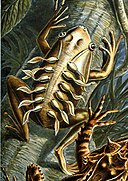Fil:Haeckel Batrachia.jpg

Storleik på førehandsvising: 424 × 599 pikslar. Andre oppløysingar: 170 × 240 pikslar | 339 × 480 pikslar | 543 × 768 pikslar | 724 × 1 024 pikslar | 2 323 × 3 284 pikslar.
Opphavleg fil (2 323 × 3 284 pikslar, filstorleik: 2,17 MB, MIME-type: image/jpeg)

Følgjande er henta frå filomtalen åt denne fila på Wikimedia Commons:
Filhistorikk
Klikk på dato/klokkeslett for å sjå fila slik ho var på det tidspunktet.
| Dato/klokkeslett | Miniatyrbilete | Oppløysing | Brukar | Kommentar | |
|---|---|---|---|---|---|
| gjeldande | 24. februar 2006 kl. 05:17 |  | 2 323 × 3 284 (2,17 MB) | Ragesoss | improve version, based on same original scan |
| 11. februar 2006 kl. 02:22 |  | 2 318 × 3 280 (2,21 MB) | Ragesoss | The 68th plate from Ernst Haeckel's 1899 ''Kunstformen der Natur'', depicting frogs classified as Batrachia. Category:Ernst Haeckel |
Filbruk
Dei følgjande 2 sidene bruker denne fila:
Global filbruk
Desse andre wikiane nyttar fila:
- Bruk på arz.wikipedia.org
- Bruk på ast.wikipedia.org
- Bruk på az.wikipedia.org
- Bruk på ban.wikipedia.org
- Bruk på be.wikipedia.org
- Bruk på bg.wikipedia.org
- Bruk på ca.wikipedia.org
- Bruk på ca.wikibooks.org
- Bruk på ceb.wikipedia.org
- Bruk på ckb.wikipedia.org
- Bruk på dag.wikipedia.org
- Bruk på de.wikipedia.org
- Bruk på din.wikipedia.org
- Bruk på el.wikipedia.org
- Bruk på en.wikipedia.org
- Wikipedia:Featured pictures thumbs/04
- Wikipedia:Picture of the day/June 2006
- User:Ragesoss/Haeckel
- Wikipedia:Featured picture candidates/Haeckel Batrachia.jpg
- Wikipedia:Wikipedia Signpost/2006-03-13/Features and admins
- Wikipedia:Featured picture candidates/March-2006
- Talk:Frog/Archive 3
- User talk:Ragesoss/Archive1
- Wikipedia:Picture of the day/June 12, 2006
- Wikipedia:POTD/June 12, 2006
- Wikipedia:POTD column/June 12, 2006
- Wikipedia:POTD row/June 12, 2006
- Kunstformen der Natur
- User:Samsara/Frog/Stable
- User:RichardF/POTD
- Wikipedia:WikiProject Germany/Gallery
- User talk:RichardF
- User:Froggyyes~enwiki
- Wikipedia:Featured pictures/Animals/Amphibians
- Unclean spirit
- User:Xophist/s5
- Wikipedia:Wikipedia Signpost/2006-03-13/SPV
- Talk:Alfred Russel Wallace/Archive 1
- Portal:Amphibians/Selected picture
- User:The Transhumanist/Sandbox144
Sjå meir global bruk av denne fila.







